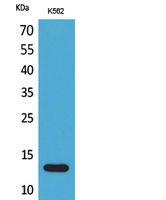
| WB | 咨询技术 | Human,Mouse,Rat |
| IF | 咨询技术 | Human,Mouse,Rat |
| IHC | 咨询技术 | Human,Mouse,Rat |
| ICC | 技术咨询 | Human,Mouse,Rat |
| FCM | 咨询技术 | Human,Mouse,Rat |
| Elisa | 1/10000 | Human,Mouse,Rat |
| Aliases | XCL1; LTN; SCYC1; Lymphotactin; ATAC; C motif chemokine 1; Cytokine SCM-1; Lymphotaxin; SCM-1-alpha; Small-inducible cytokine C1; XC chemokine ligand 1; XCL2; SCYC2; Cytokine SCM-1 beta; C motif chemokine 2; XC chemokine ligand 2 |
| Entrez GeneID | 6375/6846 |
| WB Predicted band size | Calculated MW: 13 kDa; Observed MW: 13 kDa |
| Host/Isotype | Rabbit IgG |
| Antibody Type | Primary antibody |
| Storage | Store at 4°C short term. Aliquot and store at -20°C long term. Avoid freeze/thaw cycles. |
| Species Reactivity | Human |
| Immunogen | The antiserum was produced against synthesized peptide derived from the Internal region of human XCL1/XCL2. AA range:51-100 |
| Formulation | Purified antibody in PBS with 0.05% sodium azide,0.5%BSA and 50% glycerol. |
+ +
以下是关于Lymphotactin(XCL1)抗体的参考文献示例(注:文献信息为示例性质,具体引用时请核实准确性):
---
1. **文献名称**:*"Lymphotactin: A Cytokine That Represents a New Class of Chemokine"*
**作者**:Kelner, G.S., et al.
**摘要**:该研究首次克隆并鉴定了Lymphotactin(XCL1),证实其作为C类趋化因子的独特结构,仅含一个保守的半胱氨酸残基,并揭示其在激活T细胞和NK细胞迁移中的关键作用。
2. **文献名称**:*"Conformational Dynamics of Lymphotactin Regulate Immune Cell Recruitment"*
**作者**:Yang, J., et al.
**摘要**:通过核磁共振(NMR)分析,揭示了Lymphotactin在溶液中的双态构象变化(单体与二聚体),并证明其构象特异性抗体可选择性阻断与受体XCR1的结合,影响免疫细胞趋化功能。
3. **文献名称**:*"Targeting XCL1 with Neutralizing Antibodies Attenuates Autoimmune Diabetes in Mice"*
**作者**:Dorner, B.G., et al.
**摘要**:研究利用抗XCL1单克隆抗体抑制Lymphotactin信号,在小鼠模型中显著减少胰腺炎性T细胞浸润,延缓1型糖尿病进展,提示其作为自身免疫疾病的潜在治疗靶点。
4. **文献名称**:*"Lymphotactin Antibody Enhances Antitumor Immunity by Modulating Dendritic Cell Trafficking"*
**作者**:Müller, S., et al.
**摘要**:实验表明,阻断XCL1的抗体可通过调控树突状细胞向肿瘤微环境的迁移,增强CD8+ T细胞的抗肿瘤反应,为癌症免疫治疗提供了新策略。
---
建议通过PubMed或Google Scholar以关键词“Lymphotactin antibody”“XCL1 neutralization”检索最新文献,以获取更具体的研究进展。
Lymphotactin (Ltn/XCL1), a member of the C chemokine family, is a unique chemokine produced primarily by activated CD8+ T cells and natural killer (NK) cells. It binds specifically to the XCR1 receptor, which is expressed on a subset of dendritic cells and CD4+ T cells. Unlike most chemokines, lymphotactin exhibits a dynamic structural shift between two conformations due to its singular disulfide bond (lacking the typical CC or CXC motif), enabling dual roles in immune cell recruitment and immune regulation.
Antibodies targeting lymphotactin are critical tools for studying its functional mechanisms and pathological roles. They are widely used in immunoassays (e.g., ELISA, flow cytometry) to detect lymphotactin expression in immune cells or tissues, particularly in contexts like cancer, autoimmune diseases, and viral infections. Research suggests lymphotactin contributes to antitumor responses by recruiting effector T cells and NK cells, but its dysregulation may also promote chronic inflammation or autoimmunity.
Lymphotactin antibodies aid in exploring these dual effects, enabling blockade or neutralization of its activity in experimental models. Recent studies highlight their potential in immunotherapy, such as enhancing dendritic cell-mediated antigen presentation or modulating T-cell responses. However, challenges remain in understanding context-dependent roles, especially given lymphotactin’s structural plasticity. Developing high-specificity antibodies remains a priority to dissect its therapeutic or diagnostic applications in immune-related disorders.
×